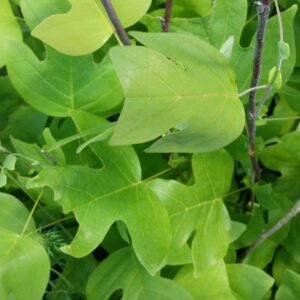Showing the single result
Wholesale Tulip Trees in Michigan For Sale
Based in Free Soil, Michigan, Cold Stream Farm supplies wholesale tulip trees for shipments across the United States. Available primarily in the spring, our tulip trees can be purchased in a variety of sizes and life stages. Please check our current stock to instantly get started with your online order.
There are currently no restrictions on shipping tulip trees of any quantity or to any region throughout the United States. Contact us with any questions about international, retail, or wholesale tulip tree deliveries from our Michigan farms.
A Background on Liriodendron tulipifera
Liriodendron tulipifera is a tall, fast-growing species native to the eastern United States. It is most commonly called the “tulip tree” due to the shape of the plant’s flowers, which resemble (but are not directly related to) ordinary, ground tulip blooms.
Growing naturally from Louisiana to Vermont, Liriodendron tulipifera trees have earned many nicknames throughout the past several centuries. Other than tulip trees, the species may be called saddle-leaf tree, canoe wood, whitewood, poplar, tulip poplar, yellow poplar, white poplar, American tulip tree, and fiddle tree.
Size and Shape
Tulip trees are one of the largest plants in eastern North America. Mature trees may grow over 120 feet in ideal conditions where there is room to thrive. The spread of a tulip tree covers up to about 50 feet, filled with rapidly growing branches sprouting leaves, flowers, and fruit.
Most branches on a tulip tree are often very weak and are prone to breaking both naturally and with the introduction of vines, people, or wildlife. Stronger branches will remain on the tree, slowly rising and bearing more seeds with increased exposure to sunlight.
Ideal Conditions for Tulip Trees
Tulip trees grow best in the midwestern and eastern United States of which they are native. Although they can adapt very well to a variety of conditions, tulip trees are ideally grown in USDA hardiness zones 4 to 9.
Soil and sunlight conditions will have a large effect on how quickly a tulip tree will grow. While slow growth can be maintained in partial sun and mild drought conditions, tulip trees prefer full sun and deep, moist soil. Slightly acidic, well-drained soils are best and tulip trees should not be planted in dry or arid regions.
Uses for Tulip Trees
Primarily, tulip trees are grown to add shade and color to a large outdoor area. They are fast-growing, have a wide canopy, and do not require much maintenance in humid conditions. Therefore, they are perfect shade trees, for parks, commercial properties, and large yards.
The wood of a tulip tree is very strong, which lends itself to use in carpentry, cabinets, and furniture making. There have been claims that tulip tree wood is termite-resistant, which has made it popular with sculptors creating works that are designed to last.
Historically, tulip trees were grown in Mt. Vernon under the oversight of George Washington. It is said that Daniel Boone created a canoe from one of these trees, by digging out a massive 60 feet trunk.
Flowers, Seeds, and Leaves
Named for their “tulip-like” flower, Liriodendron tulipifera trees bear their large pale-green and yellow blooms in the spring. The flowers are very aromatic and bloom from April to June, depending on how far north the plant is located.
Tulip tree leaves are bright green, which fade into a golden yellow in the fall. The seeds of a tulip tree are encased in a brown cone, which begin to appear in September or October and typically cling to the plant throughout the winter.
Ecology
Tulip trees attract both the birds and the bees, with their flowers and seed-like fruit. When in bloom, tulip tree flowers are a popular source of nectar, making them an important American honey plant. On the branches and leaves, it is also very common to find a wide variety of caterpillars, moths, and butterflies.
Aside from the hummingbirds, finches, and cardinals flying around, low-hanging branches on a tulip tree also receive a tremendous amount of foot traffic. The plant is popular among quails, mice, squirrels, rabbits, and more.
Common Issues with Growing Tulip Trees
Most mature tulip trees are naturally very resistant to infestations from pests as well as partial droughts and heavy winds. Vines are the most common issue with growing tulip trees, as crawling plants like grapevines will block a tree’s sunlight and add weight that will likely break weak immature branches.
Wholesale tulip trees for sale in Michigan.
Cold Stream Farm has a limited supply of tulip trees in our Michigan facilities, with retail and wholesale orders available for shipment throughout the United States and Canada. Most midsize tulip tree transplants are available in the spring, with no minimum quantity necessary on all orders. Please contact us during ordinary business hours if you have questions about current or future shipments of live tulip trees.


